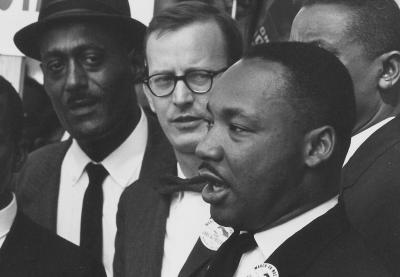Walking and other types of physical movement played a critical role in the progression of the civil rights era. But the physical movement started well before the civil rights movement, with such notable examples as Harriet Tubman and the Underground Railroad—first called the “underground road” since most people traveled by foot, not train.
Years later, in late 1955, civil rights activists launched and participated in the 381-day-long Montgomery Bus Boycott, opting to walk or travel in personal or chartered vehicles instead of riding segregated city buses. In 1963, around 250,000 people participated in the March on Washington, using their presence and voices on the National Mall to call for civil and economic rights. And two years later, in 1965, civil rights activists marched 54 miles from Selma to Montgomery, Alabama, calling for the basic right to vote.
The underlying themes of these examples and the civil rights movement at large were sacrifice and purposeful, organized action. How do educators build a deep, conceptual understanding of such abstract ideals? The first step is to set the scene.
When I was in elementary school, Dr. Martin Luther King Jr. Day was not established as an official day off from school. However, I had a mother who believed that this day should be dedicated to serving the community and learning about the dynamic life and contributions of Dr. King. My mother pulled me out of school in order to visit museums and engage in community service, and those childhood experiences imparted an important lesson in activism. Dr. Martin Luther King Jr. Day is not a day off. It’s a day out in the community where we exercise the original missions of the civil rights movement while using our voices and actions to stimulate necessary changes.
Since 2015, the school I work at has opened its doors on Dr. Martin Luther King Jr. Day so that families can gather together and walk for causes that are personally significant to them. Our district has walked 775 miles over the last two years. Each participant arrives, writes their personal cause on their nametag and then proceeds to our outdoor track for a minimum stretch of five laps. Some people have walked to take a stand against educational inequity, health disparities and bullying, just to name a few. The idea is that it’s an individual’s choice to identify an area of passion and purpose. As I scan the nametags and causes, I always gain a broader perspective of the diverse cultural values that exist in our community. And the lessons learned on this day—for students, families and educators—can be transferred back to classroom discussions and activities.
With Dr. Martin Luther King Jr. Day around the corner, here are some steps educators can take in their classrooms to prepare.
- Don’t assume. Ask your students what they know about Dr. King.
Activate background knowledge using developmentally appropriate tools. For primary grades, use a KWL chart. For upper elementary and beyond, create an anticipatory set. Note that students who have immigrated to the United States may need additional scaffolds, including bilingual learning tools. Ask these students to compare and contrast the civil rights movement in the United States with the progression of civil rights in their native countries in order to build background knowledge.
- Incorporate action-based activities.
In addition to teaching about how critical physical movement was to the civil rights era, offer opportunities for students to participate in hands-on civic engagement. It might be a school-wide event, a classroom-based activity or community service opportunity. For inspiration, see the “Do Something” tasks in Teaching Tolerance’s curriculum tool, Perspectives for a Diverse America. (Free registration required.) These tasks build civic engagement and critical literacy skills.
- Use historical primary resources.
Incorporate primary resources into your instruction, such as a virtual tour of Dr. King’s childhood home and documents and photos that require inferential thinking. For tips and suggestions for teaching with historical primary sources, see the Teaching Tolerance feature story “National Treasures.”
- Let students choose an area of research.
Instead of designing a teacher-centered unit where everyone in the class studies the same topic, create a topic list based on class discussions and questions. Then, students can develop research teams for further investigation of the topics. This approach increases engagement and promotes reciprocal learning on a larger scale.
- Infuse technology and Maker work.
Produce podcasts with students interviewing each other about the power of Dr. King’s legacy. Publish student-created web quests that chronicle the civil rights era. Ask students to create a mathematical replica of the Martin Luther King Jr. Memorial using hands-on materials.
- Invite local members of the community.
Use the resources in your community. Find out who lived through and participated in the civil rights movement. Ask them to bring in artifacts and to orally share their experiences. Allow students to create discussion questions for a local panel, and then follow up with a writing prompt for students to reflect.
Note: Find more suggestions for a meaningful MLK Day here.
Wills-Taylor, a fourth-grade teacher, is one of the five recipients of the 2016 Teaching Tolerance Award for Excellence in Teaching.


0 COMMENTS